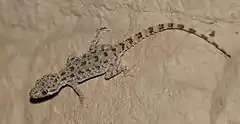| Cyrtopodion | |||
| Fitzinger, 1843[1] | |||
 Przedstawiciel rodzaju – C. scabrum | |||
| Systematyka | |||
| Domena | |||
|---|---|---|---|
| Królestwo | |||
| Typ | |||
| Podtyp | |||
| Gromada | |||
| Rząd | |||
| Infrarząd | |||
| Rodzina | |||
| Rodzaj |
Cyrtopodion | ||
| Typ nomenklatoryczny | |||
|
Stenodactylus scaber Heyden, 1827 | |||
| Synonimy | |||
|
| |||
| Gatunki | |||
| |||
Cyrtopodion – rodzaj jaszczurek z rodziny gekonowatych (Gekkonidae).
Zasięg występowania
Rodzaj obejmuje gatunki występujące w Turcji, Egipcie, Izraelu, Arabii Saudyjskiej, Omanie, Zjednoczonych Emiratach Arabskich, Kuwejcie, Katarze, Etiopii, Erytrei, Sudanie, Jordanii, Afganistanie, Iraku, Iranie, Pakistanie, Indiach i w Chinach[5][6].
Systematyka
Rodzaj zdefiniował w 1843 roku austriacki przyrodnik Leopold Fitzinger w publikacji własnego autorstwa poświęconej systematyce gadów[1]. Gatunkiem typowym jest Stenodactylus scaber.
Etymologia
- Cyrtopodion: gr. κυρτος kurtos ‘zakrzywiony’, od κυπτω kuptō ‘pochylać się’; ποδιον podion ‘stópka’, od zdrobnienia πους pous, ποδος podos ‘stopa’[7].
- Dinosaura: gr. δεινος deinos ‘straszny, potężny’[8]; σαυρος sauros ‘jaszczurka’[9]. Gatunek typowy: Stenodactylus scaber Heyden, 1827
- Mesodactylus: gr. μεσος mesos ‘środkowy, pośredni’[10]; δακτυλος daktulos ‘palec’[11]. Gatunek typowy: Gymnodactylus kachhensis Stoliczka, 1872.
- Indogekko: Indus; rodzaj Gekko Laurenti, 1768[12]. Gatunek typowy: Cyrtodactylus indusoani Khan, 1988
Podział systematyczny
Do rodzaju należą następujące gatunki[5]:
- Cyrtopodion agamuroides (Nikolsky, 1900)
- Cyrtopodion aravallensis (Gill, 1997)
- Cyrtopodion baigii Masroor, 2008
- Cyrtopodion belaense Nazarov, Ananjeva & Papenfuss, 2011
- Cyrtopodion brevipes (Blanford, 1874)
- Cyrtopodion fortmunroi (Khan, 1993)
- Cyrtopodion gastrophole (Werner, 1917)
- Cyrtopodion golubevi Nazarov, Ananjeva & Rajabizadeh, 2010
- Cyrtopodion hormozganum Nazarov, Bondarenko & Radjabizadeh, 2012
- Cyrtopodion indusoani (Khan, 1988)
- Cyrtopodion kachhense (Stoliczka, 1872)
- Cyrtopodion kiabii Ahmadzadeh, Flecks, Torki & Böhme, 2011
- Cyrtopodion kirmanense (Nikolsky, 1900)
- Cyrtopodion kohsulaimanai (Khan, 1991)
- Cyrtopodion mansarulus (Duda & Sahi, 1978)
- Cyrtopodion medogense (Zhao & Li, 1987)
- Cyrtopodion montiumsalsorum (Annandale, 1913)
- Cyrtopodion persepolense Nazarov, Ananjeva & Rajabizadeh, 2010
- Cyrtopodion potoharense Khan, 2001
- Cyrtopodion rhodocauda (Baig, 1998)
- Cyrtopodion rohtasfortai (Khan & Tasnim, 1990)
- Cyrtopodion scabrum (Heyden, 1827)
- Cyrtopodion sistanense Nazarov & Rajabizadeh, 2007
- Cyrtopodion vindhya Patel, Thackeray, Mirza & Vyas, 2023
- Cyrtopodion watsoni (Murray, 1892)
Przypisy
- 1 2 L.J.F.J. Fitzinger: Systema reptilium. Fasciculus primus, Amblyglossae. Vindobonae: Braumüller et Seidel, 1843, s. 18, 93. (łac.).
- ↑ J. von N.F.X. Gistel: Blicke in das Leben der Natur und des Menschen: ein Taschenbuch zur Verbreitung gemeinnütziger Kenntnisse insbesondere der Natur-, Länder- und Völkerkunde, Künste und Gewerbe. Leizpzig: Wartig, 1868, s. 145. (niem.).
- ↑ H.H. Щербак & М.Л. Голубев. О родовой принадлежности и внутриродовой структуре палеарктических голопалых гекконов (Reptilia, Gekkonidae, Tenuidactylus gen. n.). „Вестник Зоологии”. 1984 (2), s. 52, 1984. (ros.).
- ↑ Khan 2003 ↓, s. 3.
- 1 2 P. Uetz & J. Hallermann: Genus: Cyrtopodion. The Reptile Database. [dostęp 2023-12-24]. (ang.).
- ↑ R. Midtgaard: Cyrtopodion. RepFocus. [dostęp 2023-12-24]. (ang.).
- ↑ P. Mikaili & J. Shayegh. The lizards of Iran: An etymological review of families Gekkonidae, Eublepharidae, Angnidae, Agamidae. „Annals of Biological Research”. 2 (5), s. 28, 2011. (ang.).
- ↑ Jaeger 1959 ↓, s. 81.
- ↑ Jaeger 1959 ↓, s. 229.
- ↑ Jaeger 1959 ↓, s. 154.
- ↑ Jaeger 1959 ↓, s. 75.
- ↑ Khan 2003 ↓, s. 4.
Bibliografia
- E.C. Jaeger: Source-book of biological names and terms. Wyd. 3 (Revised second printing). Springfield: Charles C. Thomas, 1959, s. 1–316. (ang.).
- M.S. Khan. Questions of generic designation of angular-toed geckos of Pakistan with descriptions of three new genera (Reptilia: Gekkonidae). „Journal of Natural History and Wildlife”. 2 (2), s. 1–9, 2003. (ang.).
This article is issued from Wikipedia. The text is licensed under Creative Commons - Attribution - Sharealike. Additional terms may apply for the media files.